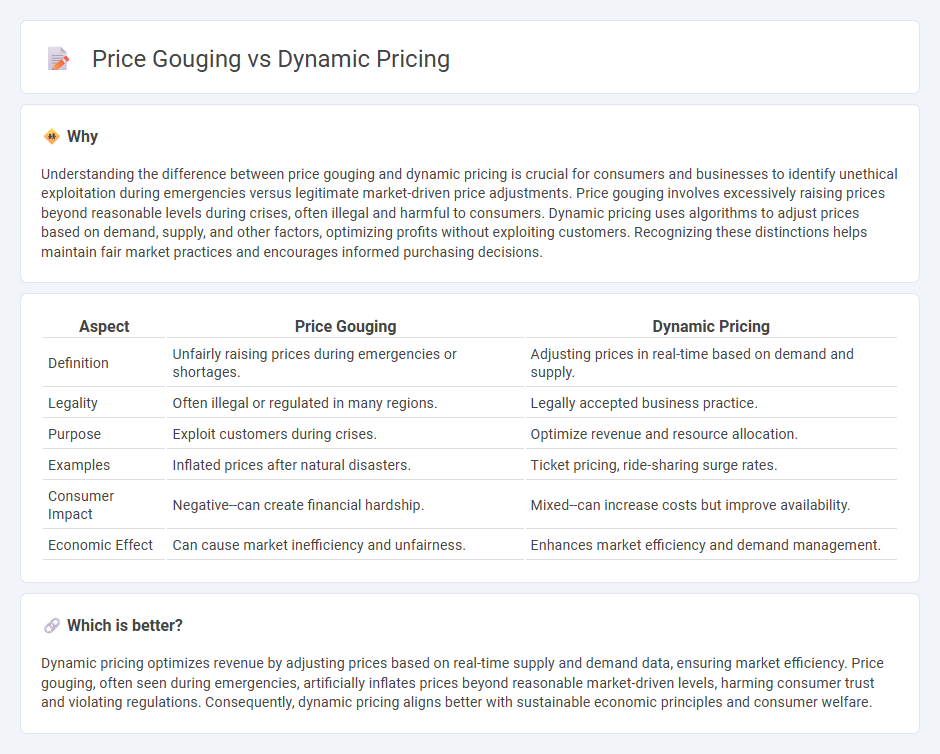
Price gouging occurs when sellers exploit demand spikes or emergencies to charge excessive prices, undermining market fairness and consumer trust. Dynamic pricing adjusts costs based on real-time supply and demand, optimizing revenue while reflecting market conditions. Explore the key differences between these pricing strategies and their economic impacts.
Why it is important
Understanding the difference between price gouging and dynamic pricing is crucial for consumers and businesses to identify unethical exploitation during emergencies versus legitimate market-driven price adjustments. Price gouging involves excessively raising prices beyond reasonable levels during crises, often illegal and harmful to consumers. Dynamic pricing uses algorithms to adjust prices based on demand, supply, and other factors, optimizing profits without exploiting customers. Recognizing these distinctions helps maintain fair market practices and encourages informed purchasing decisions.
Comparison Table
| Aspect | Price Gouging | Dynamic Pricing |
|---|---|---|
| Definition | Unfairly raising prices during emergencies or shortages. | Adjusting prices in real-time based on demand and supply. |
| Legality | Often illegal or regulated in many regions. | Legally accepted business practice. |
| Purpose | Exploit customers during crises. | Optimize revenue and resource allocation. |
| Examples | Inflated prices after natural disasters. | Ticket pricing, ride-sharing surge rates. |
| Consumer Impact | Negative--can create financial hardship. | Mixed--can increase costs but improve availability. |
| Economic Effect | Can cause market inefficiency and unfairness. | Enhances market efficiency and demand management. |
Which is better?
Dynamic pricing optimizes revenue by adjusting prices based on real-time supply and demand data, ensuring market efficiency. Price gouging, often seen during emergencies, artificially inflates prices beyond reasonable market-driven levels, harming consumer trust and violating regulations. Consequently, dynamic pricing aligns better with sustainable economic principles and consumer welfare.
Connection
Price gouging and dynamic pricing both involve adjusting prices based on market conditions, but they serve different purposes and operate under distinct ethical frameworks. Dynamic pricing uses algorithms to optimize prices according to real-time demand and supply data, enhancing revenue efficiency in industries like airlines and e-commerce. Price gouging occurs when sellers exploit emergencies by drastically increasing prices beyond reasonable levels, often triggering legal and consumer backlash.
Key Terms
Supply and Demand
Dynamic pricing adjusts product costs in real-time based on supply and demand fluctuations, optimizing revenue and inventory management for businesses. Price gouging occurs when sellers excessively increase prices during emergencies or shortages, exploiting high demand and limited supply. Explore how ethical pricing strategies balance market forces and consumer protection effectively.
Market Regulation
Dynamic pricing adjusts product prices based on real-time market demand, customer behavior, and competitor pricing, optimizing profits without breaching ethical boundaries. Price gouging occurs when sellers exploit emergencies or shortages by setting excessively high prices, often leading to legal interventions and market regulation enforcement. Explore how regulatory bodies differentiate and control these practices to protect consumers and maintain fair market competition.
Consumer Welfare
Dynamic pricing optimizes consumer welfare by adjusting prices based on demand fluctuations, inventory levels, and market conditions, ensuring fair value and product accessibility. Price gouging, in contrast, exploits emergencies by inflating prices excessively, causing consumer harm and reduced affordability. Explore how pricing strategies impact consumer welfare and regulatory frameworks for deeper insights.
Source and External Links
Dynamic Pricing: What Is It & How It Effects E-Commerce - Dynamic pricing is a strategy where e-commerce businesses adjust prices in real time based on demand, competition, and supply, leading to optimized revenue and pricing agility.
What is Dynamic Pricing? - DealHub - Dynamic pricing fluctuates product or service prices based on real-time market conditions, using data on supply, demand, competitor pricing, and customer behavior to maximize profitability.
Dynamic pricing - Wikipedia - Dynamic pricing, also known as surge or demand pricing, is a flexible pricing strategy that adjusts prices according to current market demand, encouraging efficient resource allocation across industries like hospitality, retail, and public transport.
 dowidth.com
dowidth.com